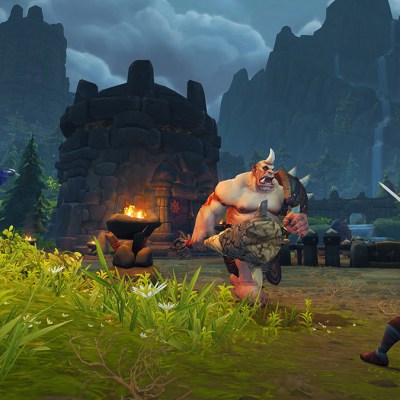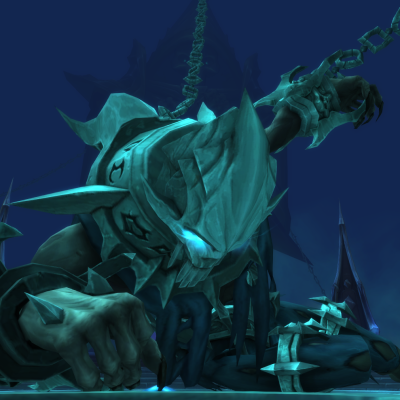By the end of World of Warcraft‘s last expansion, Battle for Azeroth, the usual fatigue that accompanies the final days of a WoW expansion was amplified by the belief that Blizzard was no longer in control of its 16-year-old MMORPG giant. There were some players who felt that Activision’s influence on Blizzard had corrupted the company’s spirit. Others who had just gotten a taste of World of Warcraft Classic bemoaned the loss of the social elements that had once defined the game. There was a general feeling that Blizzard was doing all it could to keep WoW afloat while longtime fans were impatiently waiting for the MMO to embark upon its next great adventure.
In many ways, Blizzard wants Shadowlands to be that great adventure. More importantly, the studio seems to want Shadowlands to be the expansion that helps reset WoW and wipes away some of the mistakes that the team has made in recent years. After hours of playing Shadowlands, it seems the expansion is on track to do just that, even as the ghosts of the past decisions threaten to drag the MMO back down into a void of complacency.
Shadowlands makes a good first impression. Shortly after starting the expansion’s primary questline, you’re thrown into The Maw, a kind of uber-Hell where the worst of the worst go when they die. The problem is that it seems every soul has been sent to The Maw recently, which has allowed the realm’s ruler, a Thanos-like creature known as The Jailer, to build an army of the damned. With help from the recently crowned Lich Queen, Sylvanas Windrunner, The Jailer plans to use this army to take over all the realms of the Shadowlands and Azeroth as well.
This setup is a simple, but effective way to not only introduce players to the lore of Shadowlands but to once again put all players under the thumb of a universal threat. You will miss out on many, many bits of lore by hopping into Shadowlands without knowing anything about the history of World of Warcraft mythology, but it’s easy enough to understand and enjoy the standalone plot that Shadowlands offers.
More importantly, the entire Shadowlands concept seems to have brought out the best of the game’s talented artists and designers. Each zone in Shadowlands essentially serves as a different version of the afterlife. This idea is beautifully demonstrated by Shadowlands’ starting zone, Bastion, which is a kind of an Elysian Fields version of the afterlife where angelic figures roam fields of wheat. It stands in stark contrast to the next zone, Maldraxxus, where necromancers train the souls of the damned as well as warriors who refused to stop fighting even in death.
It’s entirely possible to enjoy your time in World of Warcraft without diving into the story or lore, but it’s a testament to the design of Shadowlands‘ worlds that the lore is built into every corner of each new zone in such a way that you end up appreciating what the team has built even if you skip every line of dialogue en route to the endgame.
Yet, the biggest highlight in Shadowlands is the level squish. Blizzard’s decision to reduce the level cap from 120 to 60 not only helps the game feel much more approachable for new players (even if the leveling time is about the same) but also ensures that reaching a new level feels more significant. While vital talent points are only acquired every five levels from level 15 on, each new level typically rewards you with some kind of new skill or dungeon to explore.
While I leveled my first Shadowlands character (a Shadow Priest) to 50 during the expansion’s pre-patch period, the journey from 50-60 was made that much better by the Shadowlands‘ combination of largely exceptional world design and the fact that there was something new to explore with each new “ding.” Shadowlands offers a nearly universal leveling experience for first time level 50-60 players, and the expansion’s campaign does a fairly good job of making that progression relatively painless. I especially enjoyed the way the game now clearly marks campaign quests and side quests, making it that much easier for players to reach 60 as fast as possible.
Release Date: Nov. 23, 2020
Platform: PC
Developer: Blizzard
Publisher: Blizzard
Genre: MMORPG
That may sound like an odd bit of praise for those out of the loop or anyone who hasn’t played WoW since its early days, but the truth of the matter is that WoW just isn’t about the leveling experience anymore. Blizzard has done everything reasonably in its power to make the journey from 1-60 as efficient as possible. As someone who really got into WoW with the release of Classic, there’s a part of me that is always going to miss the idea that the journey to the level cap should be this epic adventure filled with leveling zones, dungeon runs, and a slow but steady mastery of your character’s abilities and equipment. I suspect there’s a happier middle-ground between modern WoW leveling and WoW Classic leveling, but if you accept that Shadowlands leveling is just meant to be a narrative-driven prelude to the endgame, then it’s a lot easier to appreciate the campaign the team has designed.
That being said, there are some aspects of Shadowland‘s leveling experience that simply do not work. Quests remain one of the game’s biggest issues. World of Warcraft quests have always been somewhat infamous for their simplicity (many of the WoW Classic quests really do boil down to “Collect X Item”), but Blizzard has tried to make the questing process more enjoyable in recent years by creating tighter questline narratives and ensuring you have to travel shorter distances between objectives.
All of that makes questing more efficient, but little of it makes questing more interesting. Most quests follow the same basic tropes and are easy enough to complete without any help from friends or other players. That last part is especially disappointing as the release of a new expansion should be the best time to embraces the benefits of an influx in players. Instead, I’m often left running around working through the same basic skill rotation to complete a similar series of quests by myself.
This is where dungeons should come in to help break up the monotony, but they’re kind of in a weird spot at the moment. I love the design of the Shadowlands dungeons I’ve queued into so far from both a thematic and gameplay standpoint, but they’re just not designed to be woven into the leveling experience quite in the same way that they were in the past. You don’t really “need” to run dungeons until you’re grinding for better gear in the late game. That approach removes a golden opportunity to capitalize on the “massively multiplayer” element of a massively multiplayer online role-playing game.
Read more
Thankfully, the role-playing portion of the experience fares pretty well. I’ve already praised Shadowlands‘ story and world-building, but so far, I’m also happy with how Blizzard has balanced the various characters and races. Yes, some classes will offer a statistical advantage over others, but that’s unavoidable. What’s impressive is that you get the feeling you can truly play Shadowlands as any class/race/specialization combination you choose and not have to worry about being ousted by other players until you get into high-end raiding. Time (and the growth of Shadowlands‘ PvP scene) will reveal just how balanced Shadowlands really is, but what’s important right now is that most classes feel like they have some semblance of identity and are not so unbalanced that you need to prioritize anything but your role-playing preferences.
Battle for Azeroth‘s problem wasn’t necessarily its leveling experience (it actually featured a strong narrative and some great zones), but if we treat the journey to the level cap as a guided campaign, I generally feel that Shadowlands is a stronger expansion overall due to its level squish and better overall world building.
What remains to be seen is whether or not Shadowlands‘ endgame content thrives where Battle for Azeroth failed. I already feel like Torghast will offer a far better endgame experience than BfA‘s dreadful Island Expeditions, and legendary crafting and Covenant faction experiences feel more exciting than Heart of Azeroth and Warfronts. I’m still worried that the new Anima resource system will replicate the mistakes of BfA‘s Azerite system, which too often negated the thrill of acquiring new items through dungeons and raids, but it doesn’t seem to be quite that invasive so far.
As it stands right now, I haven’t put enough hours into Shadowlands endgame yet to render a verdict on the expansion’s most important long-term features. Considering that much of Shadowland‘s endgame isn’t even available yet, including the remaining Torghast floors and the expansion’s first raid, there’s still a lot of ground to cover. What I can tell you is that Shadowlands offers a worthwhile leveling experience that represents a better version of modern WoW than we’ve seen in recent years, even if it’s not quite the extensive overhaul that some were hoping for.
With the release of Shadowlands, Blizzard seems to have rescued WoW from some really rocky waters. Now, we just have to hope the team uses its considerable resources to do more than just stay adrift.


